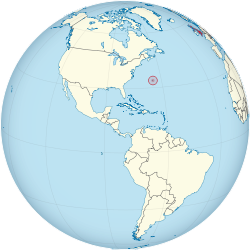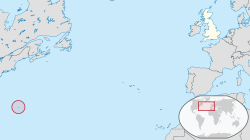
Back Bermuda Afrikaans Bermuda ALS ቤርሙዳ Amharic Bermudas AN Bermuda ANG बरमूडा ANP برمودا Arabic برمودا ARZ Les Bermudes AST Bermud adaları Azerbaijani
Bermuda | |
|---|---|
| Motto: | |
| Anthem: "God Save the King" | |
| National song: "[acting]" | |
| Sovereign state | |
| English settlement | 1609 (officially becoming part of the Colony of Virginia in 1612) |
| Capital and largest city | Hamilton 32°17′46″N 64°46′58″W / 32.29611°N 64.78278°W |
| Official languages | English |
| Ethnic groups (2016[2]) |
|
| Demonym(s) |
|
| Government | Parliamentary dependency under a constitutional monarchy |
• Monarch | Charles III |
• Governor | Rena Lalgie |
• Premier | Edward David Burt |
| Legislature | Parliament |
| Senate | |
| House of Assembly | |
| Government of the United Kingdom | |
• Minister | Stephen Doughty |
| Area | |
• Total | 53.2 km2 (20.5 sq mi) |
• Water (%) | 27 |
| Highest elevation | 79 m (259 ft) |
| Population | |
• 2019 estimate | 63,913[3] (205th) |
• 2016 census | 63,779 |
• Density | 1,338/km2 (3,465.4/sq mi) (10th) |
| GDP (nominal) | 2019 estimate |
• Total | US$7.484 billion[3] (161st) |
• Per capita | US$117,097 (4th) |
| HDI (2013) | very high |
| Currency | Bermudian dollar (BMD) |
| Time zone | UTC−04:00 (AST[a]) |
• Summer (DST) | UTC−03:00 (ADT) |
| Date format | dd/mm/yyyy |
| Driving side | left |
| Calling code | +1-441 |
| Postal codes | CR01 to CR04, DD01 to DD03, DV01 to DV08, FL01 to FL08, GE01 to GE05, GECX, HM01 to HM20, HS01, HS02, MA01 to MA06, PG01 to PG06, SB01 to SB04, SN01 to SN04, WK01 to WK10[5] |
| ISO 3166 code | |
| Internet TLD | .bm |
| Website | https://www.gov.bm/ |
Bermuda (/bərˈmjuːdə/; historically known as the Bermudas or Somers Isles) is a British Overseas Territory in the North Atlantic Ocean. The closest land outside the territory is in the American state of North Carolina, about 1,035 km (643 mi) to the west-northwest.
Bermuda is an archipelago consisting of 181 islands, although the most significant islands are connected by bridges and appear to form one landmass. It has a land area of 54 square kilometres (21 sq mi). Bermuda has a tropical climate, with warm winters and hot summers. Its climate also exhibits oceanic features similar to other coastal areas in the Northern Hemisphere with warm, moist air from the ocean ensuring relatively high humidity and stabilising temperatures. Bermuda is prone to severe weather from recurving tropical cyclones; however, it receives some protection from a coral reef and its position north of the Main Development Region, which limits the direction and severity of approaching storms.
Bermuda is named after Spanish explorer Juan de Bermúdez, who discovered the archipelago in 1505. The islands have been permanently inhabited since 1612 when an English settlement was established at St. George's, which is also the territory’s largest settlement. Forming part of British America, Bermuda was governed under Royal charter by the Somers Isles Company until 1684, when it became a crown colony. The first enslaved Africans were taken to Bermuda in 1616. The Somers Isles Company ensured a steady flow of free but indentured servants until 1684, and most tobacco farms owned by overseas adventurers were sold to the tenants or other occupants after Bermuda-grown tobacco became steadily less profitable following the 1620s, becoming family farms that switched from growing tobacco for export to producing food (initially for local consumption).[6] Consequently, a plantation economy did not develop and the slave trade largely ceased by the end of the 17th century.[7] The economy instead became maritime-focused, with the colony serving as a base for merchants, privateers and the Royal Navy, giving its name to the Bermuda rig and Bermuda sloop. It became an imperial fortress, the most important British naval and military base in the western hemisphere with vast funds lavished on its Royal Naval Dockyard and military defences until the 1950s. Tourism has been a significant contributor to Bermuda's economy since the 19th century and after World War II, the territory became a prominent offshore financial centre and tax haven.
Divided into nine parishes, Bermuda is a self-governing parliamentary democracy with a bicameral parliament located in the capital Hamilton. The House of Assembly dates from 1620, making it one of the world's oldest legislatures. The premier is the head of government and is formally appointed by the governor, who is nominated by the British government as the representative of the King. The United Kingdom is responsible for foreign affairs and defence. An independence referendum was held in 1995 with a large majority voting against independence. As of 2019, Bermuda had a population of around 64,000 people, making it the second-most populous of the British Overseas Territories. Black Bermudians, a diverse population primarily of any mixture of African, European, and Native American ancestry,[8][9] make up around 50% of the population, while White Bermudians, primarily of British, Irish and Portuguese descent, make up 30% of the population. There are smaller groups from other races or identifying as mixed race and about 30% of the population is not Bermudian by birth. The last remaining colony in the former British North America (following the 1867 Confederation of Canada and the Colony of Newfoundland becoming the Dominion of Newfoundland in 1907), Bermuda has a distinct dialect of English and has historically had strong ties with other English-speaking countries in the Americas, including the United States, Canada, and the Commonwealth Caribbean. It is an associate member of the Caribbean Community.
- ^
"Bermuda". CIA World Factbook. North America. July 2018. Archived from the original on 9 January 2021. Retrieved 4 February 2019.
 This article incorporates public domain material from The World Factbook. CIA.
This article incorporates public domain material from The World Factbook. CIA.
- ^ "Bermuda 2016 Census" (PDF). Bermuda Department of Statistics. December 2016. Archived (PDF) from the original on 15 July 2020. Retrieved 22 March 2020.
- ^ a b "Data". data.worldbank.org. Bermuda. Archived from the original on 9 August 2021. Retrieved 9 August 2021.
- ^ "Time Zone Act" (PDF). Archived from the original (PDF) on 20 October 2020.
- ^ "Bermuda Postal Codes". postalcodes.azinfoportal.com. Retrieved 8 March 2024.
- ^ Lefroy, Sir John Henry (1981). Memorials of the Discovery and Early Settlement of the Bermudas or Somers Islands 1515-1685, Volume I. Bermuda: The Bermuda Historical Society and The Bermuda National Trust (the first edition having been published in 1877, with funds provided by the Government of Bermuda), printed in Canada by The University of Toronto Press.
- ^ Smith, James E. (1976). Slavery in Bermuda. USA: Vantage Press. ISBN 978-0533020430.
- ^ indexed by A. C. Hollis Hallett. Updated by: C. F. E. Hollis Hallett (2005). 19th Century Church Registers of Bermuda. Bermuda: Juniperhill Press and Bermuda Maritime Museum Press. Page x, Guide to the Use of this Index: Coloured and White. ISBN 0-921992-23-8.
Today, the term 'Coloured' as a racial distinction referring to the Black population is no longer used, but in the period covered by this index it was the usual term and has been retained......We suspect that the clergy generally made a decision whether they would describe a person as 'White', and the 'Coloured' designation was used for everyone not described as 'White'. Users of this index should not confine themselves to 'White' or 'Coloured' registers (where they are separated) but should look at both. They should also not take too seriously the indication 'Col.' or 'Wh.' that appears often under Comments; these were occasionally written into the margins of the register by the clergyman or parish clerk.
- ^ JJill B. Gaieski,1 Amanda C. Owings,1 Miguel G. Vilar,1 Matthew C. Dulik,1 David F. Gaieski,2 Rachel M. Gittelman,1 John Lindo,1 Lydia Gau,1 Theodore G. Schurr1*, and The Genographic Consortium (1 = Department of Anthropology, University of Pennsylvania, Philadelphia, PA 19104; 2 = Department of Emergency Medicine, Hospital of the University of Pennsylvania, Philadelphia, PA 19104) (2011). "Genetic Ancestry and Indigenous Heritage in a Native American Descendant Community in Bermuda". American Journal of Physical Anthropology. 146 (3). AMERICAN JOURNAL OF PHYSICAL ANTHROPOLOGY (Volume146, Issue 3, November 2011, Pages 392-405): 392–405. doi:10.1002/ajpa.21588. ISSN 0002-9483. PMID 21994016. Retrieved 7 April 2024.
the non-white population....we analyzed genetic variation among members of this community....Our results reveal that the majority of mitochondrial DNA (mtDNA) and Y-chromosome haplotypes are of African and West Eurasian origin. However, unlike other English-speaking New World colonies, most African mtDNA haplotypes appear to derive from central and southeast Africa, reflecting the extent of maritime activities in the region........RESULTS: mtDNA diversity...The majority of mtDNA lineages observed in Bermudians (68%) originated in Africa....West Eurasian haplogroups comprised 31% of the Bermudian mtDNA haplotypes..... Y-chromosome diversity...one-third of the Bermudian male participants, had three NRY haplogroups of African ancestry...West Eurasian haplogroups accounted for the majority of the male participants and the vast majority of their Y-chromosomes....More than two-thirds of the mtDNAs (68%) are of African origin, and approximately one-third of them (31%) are of European origin. By contrast, Native American lineages constitute less than 1% of Bermudian mtDNAs, somewhat less was expected based on oral histories and archival data....The NRY haplogroup data likewise reveal clear contributions from the same two major source areas. However, the trend is reversed, with European lineages accounting for 66% of St. David's Islander Y-chromosomes and African lineages accounting for 32% of them. Native American haplogroups comprised only 2% of Bermudian Y-chromosomes, less than anticipated based on oral history and archival data.
{{cite journal}}: CS1 maint: multiple names: authors list (link) CS1 maint: numeric names: authors list (link)
Cite error: There are <ref group=lower-alpha> tags or {{efn}} templates on this page, but the references will not show without a {{reflist|group=lower-alpha}} template or {{notelist}} template (see the help page).



